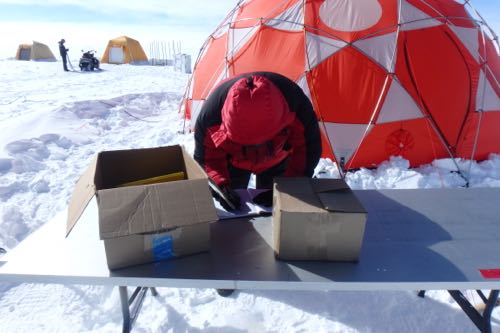Our team headed out to the drilling site right after the morning meeting so that we would have as much time as possible to collect core samples. Unfortunately, science doesn't always go according to plans. We ended up up having lots of problems with the drill that delayed us a great deal.
The samples that we are collecting are of firn, not ice. The difference is that firn is old snow that gets compacted as future layers of snow build up on it. As you go deeper and deeper, the snow is more and more compacted. Here at Summit Station, there needs to be about 80 meters of snow built up before it becomes ice.
Even though firn is much softer than ice, it is harder for the drill to get samples from. After boring down into the firn, the drill then needs to "grab" the sample to bring it back up. This was the main source of our problems today.
While the professional drillers were working on solving the problems, the rest of the team set to work setting up a processing area. This included a place to remove the core from the drill, the boxes and bags that will hold the samples, and a pit that will help keep the boxes of core samples extremely cold. Even though the air temperature today was only about 1 degree Fahrenheit, the sun would impact the core samples. The pit helps stop this from happening.
 Researcher, Eric Wagner, lays in the pit created to hold the core samples before they are transported back to the station.
Researcher, Eric Wagner, lays in the pit created to hold the core samples before they are transported back to the station.
 The drillers worked hard to diagnose and repair the problems that arose with the drill today.
The drillers worked hard to diagnose and repair the problems that arose with the drill today.
Eventually, the problems were solved and we were able to start collecting samples. In a future journal, I will go through the specifics of how we log and process each core sample for later testing.
 Researcher, Ian Baker, logs information about the ice core samples that were retrieved.
Researcher, Ian Baker, logs information about the ice core samples that were retrieved.
Parhelion
While at the drilling site today, we were fortunate enough to observe an amazing weather phenomenon called a parhelion (also called a sun dog).
 The team observed this amazing example of a parhelion while at the drilling site.
The team observed this amazing example of a parhelion while at the drilling site.
As you probably know, white light is actually made up of light of all of the colors in the rainbow. When it passes through a prism or water droplets, the white light is refracted, which means that it bends. Each color of light is refracted slightly differently, resulting in a rainbow coming out the other end.
The parhelion is caused when there are ice crystals in the air near the surface. We had this condition today due to some fog in the area. When the sun's light hits the ice crystals, it can be refracted and reflected. If the orientation of the ice crystals is just right, it creates a rainbow and/or light flares in the sky. The one we observed today was a very good example of this.
 Parhelion, or sun dogs, are caused by ice crystals in the air.
Parhelion, or sun dogs, are caused by ice crystals in the air.
PolarConnect Event
On Tuesday, June 20th, the team will be hosting a live event to talk about our mission and our time at Summit Station. It will be held at 2:00 PM our time, which is noon Eastern Time. You can register for this event at: https://www.polartrec.com/polar-connect/register[https://www.polartrec.com/polar-connect/register]
Congratulations to My Son
Please forgive me taking part of my journal for a personal note, but I wanted to congratulate my son, Zach, who graduated from the University of Chicago today. I wish I could have been there for his graduation, but he understands. I am very proud of him!! I also know that most people who work in remote areas make huge personal sacrifices and miss events in their own lives.
Polar Profile
Name: Grey Davis
Job Title: Summit Station Operations Manager
 Grey Davis is the manager of Summit Station.
Grey Davis is the manager of Summit Station.
Home: Sande Point, ID
Length of Time Working in Polar Regions: Grey has worked in both the Arctic and Antarctic since 2004.
Length of Current Assignment to Summit Station: Grey spends a few months each year on station. The rest of the year, he works from home to take care of the logistics for the station.
Job Description: Grey oversees and tracks the daily details of running the station.
Favorite Part of Working at Summit Station: Grey says that he likes it all - the travel, the people he works with while here, and the fact that he gets to work from home part of the year.
Hardest Part of Working at Summit Station: Grey says the hardest part of working at Summit Station is the fact that he has to work such long hours while here.


Add new comment